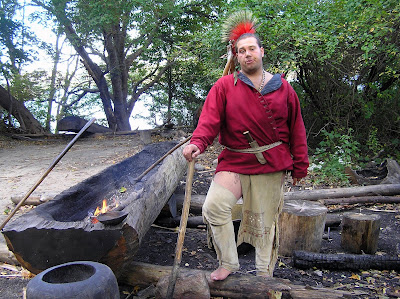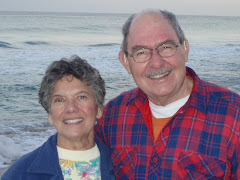Madeline and I took a pleasant hike through the woods to the old Savage Mill. This is the site of a mill built in the late 1700's or early 1800's, on a stream near, but not on, what is now an abandoned road. The road has been cleared to some extent, for snowmobiles. When I was a kid, living in the area, we used to follow these old roads out in the woods, fairly easily, since most of the original roads were bordered by stone walls. I recalled that we had to leave the old road and traipse off thru the woods, about 400-500 yards, to find the mill. Madeline and I made a number of futile side trips to find the mill. Just when we were ready to give up, I made a last trip into the woods, and there I found the remains of the old mill dam, a line of stone walls about eight feet high. We the found the old walls, where the water wheel must have been. These walls are quite imposing --- two wall, fifteen to twenty feet high and about twelve feet or so apart.
There was a little bridge built across the walls, and a path leading to it -- so obviously there was an easier way, then we took, to get to the old mill. The picture below is of me standing on the little wooden bridge across where the water wheel once stood.
 This was fall in New Hampshire, and the trees were beginning to turn. As one travels through the woods, In wet areas, an occasional tree will be seen all in scarlet or yellow colors.
This was fall in New Hampshire, and the trees were beginning to turn. As one travels through the woods, In wet areas, an occasional tree will be seen all in scarlet or yellow colors.
 On the way back to our car, we saw very colorful mushrooms, growing on old dead trees.
On the way back to our car, we saw very colorful mushrooms, growing on old dead trees.
 After the weekend we traveled down to Plymouth Mass, where we visited the Plimoth Plantation. This is a reconstruction of the town of Plymouth as it stood around 1630, approximately 10 years after the Pilgrims arrived. There is also a reconstructed Wampanoag Indian village, a tribe the was present when the settlers first arrive in Plymouth, and helped the early settlers survive during the early years. Indians in the village helped explain how life was in the 1600's. I was interested in the man, shown below making boats out of logs. He said he could complete a boat in about three days.
After the weekend we traveled down to Plymouth Mass, where we visited the Plimoth Plantation. This is a reconstruction of the town of Plymouth as it stood around 1630, approximately 10 years after the Pilgrims arrived. There is also a reconstructed Wampanoag Indian village, a tribe the was present when the settlers first arrive in Plymouth, and helped the early settlers survive during the early years. Indians in the village helped explain how life was in the 1600's. I was interested in the man, shown below making boats out of logs. He said he could complete a boat in about three days. 
Below is shown what was a typical Indian dwelling, known to us as a wig warm. it is made of bark attached to lengths of bent saplings, and is quite good, i was told in keeping out snow and rain.

The Plymouth colony has been reconstructed. The village is surrounded with a palisade of logs. The hut have thatched roofs, and the walls are made of a mixture of mud and straw on the inside, and wood on the outside. There were people acting the part some of the colonist, and acting as if they were actually there on a day in 1630. Two interesting characters to me were William Hopkins, and William Bradford. Bradford and I are related, whereas Hopkins and I are not.


We also went to the actual town of Plymouth. There we saw a reconstruction of the Mayflower. The Mayflower was more substantial than I expected, although exceedingly small for the number of passengers. This reconstructed ship at one time actually sailed across the Atlantic Ocean.
We also saw Plymouth Rock. I gather the rock is much smaller than originally, and there is some question, if the first settlers actually stepped on it. However, I gather it was a landmark on a long and predominately sandy beach.

From Plymouth we moved on to Upstate New York where we visited Madeline's brothers and their families, and Madeline did genealogical research --- visiting historical societies, libraries and county court houses. While there we rendezvoused with Madeline's brother. who delivered our Jeep that we purchased from a fellow RVer in California.

From Plymouth we moved on to Upstate New York where we visited Madeline's brothers and their families, and Madeline did genealogical research --- visiting historical societies, libraries and county court houses. While there we rendezvoused with Madeline's brother. who delivered our Jeep that we purchased from a fellow RVer in California.
After spending sometime in New York, we traveled to Rhinebeck, a small town down in the Catskills, about 50 miles from New York City. There we visited Rhinebeck Aerodrome, site of a museum of World War I and before, airplanes. We also saw an air show. perhaps i will have some pictures in a future posting. There was an old German tri-plane, the type famously flown by the Red Barron, as well as a Spade, and a Sopworth Camel (the type flown by Snoopy. Most of theses planes as well as others are in flying condition, and indeed were flow, while we were there. there are some older planes also, probably in flying condition, but so primitive, that it is doubtful if it is safe to fly them. some of these were taxied up and down the airfield. It was amusing to learn that some of the airplanes did not have brakes, so two men would have to catch them to stop them and to turn them around.
The next day we visited Franklin Roosevelt's birthplace and home in Hyde Park, New York. There is tour through the home, and then an extensive museum at the Roosevelt national Library. There is also a separate 'cottage" that Eleanor Roosevelt lived in, and another one Franklin built, as "get away".
We are now in Virginia visiting our son and his family. Tomorrow, we move on to the Charlotte, NC area to get repairs and maintenance on our rig.


No comments:
Post a Comment